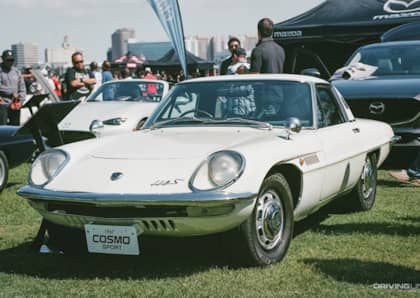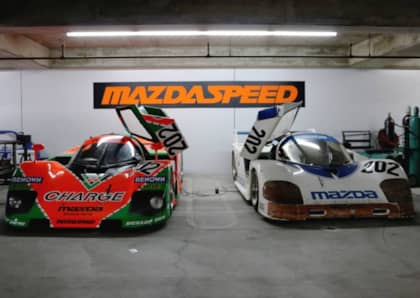The ‘60s Mazda Cosmo Was a Small Package With Big Ambitions
Japan, in the 1960s was a nation ready to stretch out and show the world what their re-built manufacturing might could accomplish. The harsh postwar era, where spiritual defeat and industrial destruction dominated every aspect of life, seemed to finally be behind them. The Land of the Rising Sun wanted to make it clear that they were capable of much more than tin toys and transistor radios.

The Swingin’ Sixties put a heavy focus on fun, and what was more fun than small two-seat sports cars. The British and the Italians were selling agile, lightweight roadsters as fast as they could bolt them together. This didn’t go unnoticed by the Japanese carmakers. Built for the Japanese market, the Cosmo was a right hand drive marvel of innovation.

Japanese car companies had been building small and efficient transportation throughout the ‘50s. Now manufacturers wanted to make a statement. Tokyo was to host the 1964 Olympics; something considered impossible only a decade before. Just weeks before the world would travel to Japan, Mazda stunned the car world with a fun-looking sports car powered by a ROTARY engine. Built in Hiroshima, no less, Mazda demonstrated that Japan had the balls to come up with something completely new – The Cosmo.

Rotary Power Made More Promising
The rotary engine concept had been patented in 1929 by Felix Wankel. In the ‘50s the German car company NSU developed the design into working engines that offered simplicity, light weight and small size, compared to piston engines generating equal power. Everything sounded good on paper, but in reality the Germans had trouble making the seals last and the fuel economy wasn’t great.

Mazda was one of several manufactures interested in the rotary and made a deal with NSU to develop the promising engine design further. After years of frustration, Mazda engineers finally solved the engine sealing problems. The small piston-less motor put out 110 horsepower, which was very good compared to its British and Italian contemporaries. A five-speed gearbox was also something that the Europeans could only dream about. No automobile had been put into production with a completely new type of engine since the earliest days of the horseless carriage. None of this was lost on the automotive world. Mazda would even use the rotary shape in their company logo.

Now they just needed a platform as unique as the powerplant.
Luxury Options to Usher in the Space Age
Where the British and Italian sports cars offered spartan comforts and decade-old technology, the Mazda engineers made sure that they packed luxury and innovation into their new flagship. The Steering wheel and chrome-bezeled gauges were pure tradition, but air conditioning would be a factory option that was unheard of in the European sportscars.

The A/C exit vents were another unique styling feature, located at shoulder height between the seats. The dashboard was loaded with gauges and switches, again, in sharp contrast to its European competitors. Even the name, Cosmo, was chosen to suggest the high technology of the culturally important 1960’s space race.

The slick body owes something to the Pininfarina- styled Alfa Romeo Spyders but is also unique in its many styling details. Racing-style plex-covered headlights, side vents and forward mounted mirrors all suggest a high-end automobile. The large taillights especially, with their above and below the real bumper positioning, are something only seen on the Cosmo. As a total package, the Cosmo was way ahead of its competition.

About 80 pre-production test cars were built in 1965, followed by about 1500 first-generation Cosmos built between 1967 and 1972 and all of them were for the Japanese market. They were essentially hand-built at the rate of about one per day. Their rarity has made them valuable collectors items.

This car, one of about three in the U.S., is a part of the Galpin Collection. Mazda parked it in their display at the 2015 L.A. Auto Show. Most weekend attendees walked right past it, looking for the latest custom or high-tech concept. The few who recognized it for what it was and the important place it holds in the automotive landscape could hardly believe their luck in being able to examine a Mazda Cosmo up close.

The Cosmo wasn’t built in large enough numbers to be a true world-beater. Soon after it’s debut, Toyota would uncover it’s incredible new and even more exclusive Porsche-killing 2000GT supercar. But in it’s own way the Cosmo was a cannon shot from Japan shouting to the world that Japanese industry and innovation had been reborn. And it wouldn’t be long before it was once again, a major force to be reckoned with.
Photos by Tim Sutton.











